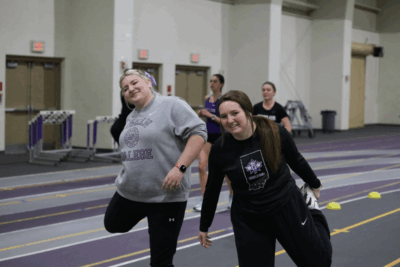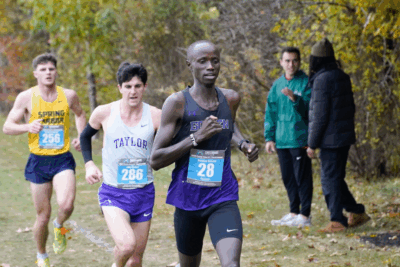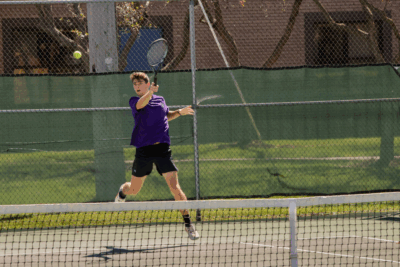In the summer of 2023, coaches of the Goshen College athletic teams were uncertain whether they would switch out of the Crossroads League and into another NAIA conference, the Chicagoland Athletic Conference, with the purpose of finding a better fit for their facilities, competitive level, enrollment size and values.
It’s not to say it won’t ever happen, but we’ve kind of committed to a few years of, ‘let’s see how this plays out.’
— Chad Coleman, interim athletic director
Coleman stepped into the role of associate athletic director in 2023 under Erica Albertin, who was the athletic director during the conference discussions. Albertin declined to comment for this article.
Similarly, Rustin Nyce, the men’s and women’s cross country coach, said, “From my perspective, it seemed pretty certain that we were moving conferences by this academic year.”
Luke Wagner, the softball coach, said that the idea of looking into a new conference, “was really exciting because it showed that we weren’t complacent, that we were really exploring some options.”
This discussion came to a halt with a decision from GC administrators to table the conversation.
“At the moment it felt like the risks and rewards and the advantages and disadvantages didn’t come to a clear yes,” said President Becky Stoltzfus.
“It’s a lot of work, a lot of relationship management, a lot of communication and a lot of rebranding to change conferences.”
The conversation around switching conferences stemmed from a variety of issues, including President Stoltzfus emphasizing the importance of recognizing attitudes toward LGBTQ+ athletes.
“We were watching the conversation about transgender athletes unfold and also just realizing that in a time when LGBTQ identities more broadly were becoming controversial and particularly amongst some of more conservative faith traditions that are represented in our conference,” said President Stolzfus.
“We also just had an eye on competitiveness and, are we in a conference at the right competitive level for us and the size of school that we are? So I think those were sort of the initial driving considerations.”
Another factor included enrollment size; GC is currently the smallest, with 717 undergraduate students, whereas many other schools in the conference have 1,500 to 2,000 undergraduate students.
Furthermore, GC’s facilities also remained a factor. Nyce explained that the thoughts on facilities was that, “In the Chicagoland, our facilities would be in about the middle of the conference. And so the idea was that we would be able to move conferences [and] be able to attract more athletes because our facilities will be better than some of the other schools in the Chicagoland Conference.”
In the Crossroads League, Huntington University recently finished a $18.7 million project to expand and redesign their athletic facilities, as well as Indiana Wesleyan University, which announced plans this October to build a $30 million basketball arena.
Several other factors also contributed to the decision to stay, including the locations and time zone of the Chicagoland Conference schools and the high ticket price that came with exiting the Crossroads League.
In addition, considering the elite nature of the Crossroads League, the academic prestige linked to the schools and GC’s relationships within the league, there are strong ties to remaining and also positive associations with being a part of the group.
“The [Crossroads League] schools are also pretty good schools that have, you know, made a name for themselves even outside of athletics,” said Coleman.
“There’s some prestige in that. And I feel like as an institution, we want to be known or talked about in the same breath as those schools, even if you’re not talking about athletics.”
In the same way that GC athletics considered switching NAIA conferences, they also considered moving to NCAA Division lll, back in 2019.
Soltzfus added, “I would say that it’s just a healthy thing to every once in a while step back and say are we in the right conference and what are the considerations?”
Tim Wilkening, a senior sports management major and member of the men’s soccer team, does not think the Crossroads League is a good fit for GC at this point in time.
“We don’t invest enough in our facilities and our coaches and our teams, which is why we’re at the bottom … every year,” Wilkening said.
“But in a long term run, I think Goshen College is a place and they have the location, the city, the people. They want to compete and I feel like this place has so much, so much more to offer.”
Marcus Northern, a sophomore business major and member of the men’s basketball team said,
“I feel like this [is] one of the best leagues in the NAIA … I don’t think we should change. I think we should always try to better ourselves and challenge ourselves.”
In the end, the decision to stay in the Crossroads League holds firm, for the time being, and there is hope that progress will still be made.
Coleman said, “It’s not to say it won’t ever happen, but we’ve kind of committed to a few years of, ‘let’s see how this plays out.’”
With GC’s Connected Cause Campaign bringing in $3.1 million for athletics, “it did give us somewhat of a hope … it’s athletics turn in the rotation in the batting order for institutional support,” Coleman said.
“So it feels like, do we really want to give up on the Crossroads before we have a chance to execute?”




